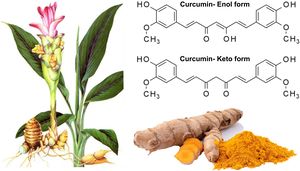Curcumin
From MEpedia, a crowd-sourced encyclopedia of ME and CFS science and history
This article is a stub. |

Turmeric and curcurmin. Image: Front. Pharmacol., 09 May 2018 Fig 1. doi.org/10.3389/fphar.2018.00472. License:CC BY-4.0
Curcurmin is the bright yellow chemical compound found in some plants, principally it is the main ingredient in turmeric. Curcumin is used in Ayurvedic medicine and traditional Chinese medicine. Medical studies using curcumin to reduce inflammation and treat ME/CFS have had promising results, however studies are small and more research is required.
Uses[edit | edit source]
Theory[edit | edit source]
it is anti-inflammatory and anti-oxidative.
Evidence[edit | edit source]
Risks and side effects[edit | edit source]
Costs and availability[edit | edit source]
Notable studies[edit | edit source]
- 2009, Curcumin, a polyphenolic antioxidant, attenuates chronic fatigue syndrome in murine water immersion stress model [1][1]
- 2018, The Effect of Curcumin on Patients with Chronic Fatigue Syndrome/Myalgic Encephalomyelitis: An Open Label Study. C. (Linda) M. C. van Campen, K. Riepma, and Frans C. Visser. International Journal of Clinical Medicine Vol.09 No.05(2018) [2]
- 2019, The effect of curcumin in patients with chronic fatigue syndrome / myalgic encephalomyelitis disparate responses in different disease severities. C (MC) Linda van Campen and Frans C Visser. Pharmacovigil and Pharmacoepi 2: 22-27. [3]
See also[edit | edit source]
Learn more[edit | edit source]
References[edit | edit source]
- ↑ Gupta, Amit; Vij, Garima; Sharma, Sameer; Tirkey, Naveen; Rishi, Praveen; Chopra, Kanwaljit (January 2009). "Curcumin, a polyphenolic antioxidant, attenuates chronic fatigue syndrome in murine water immersion stress model". Immunobiology. 214 (1): 33–39. doi:10.1016/j.imbio.2008.04.003. ISSN 0171-2985.

